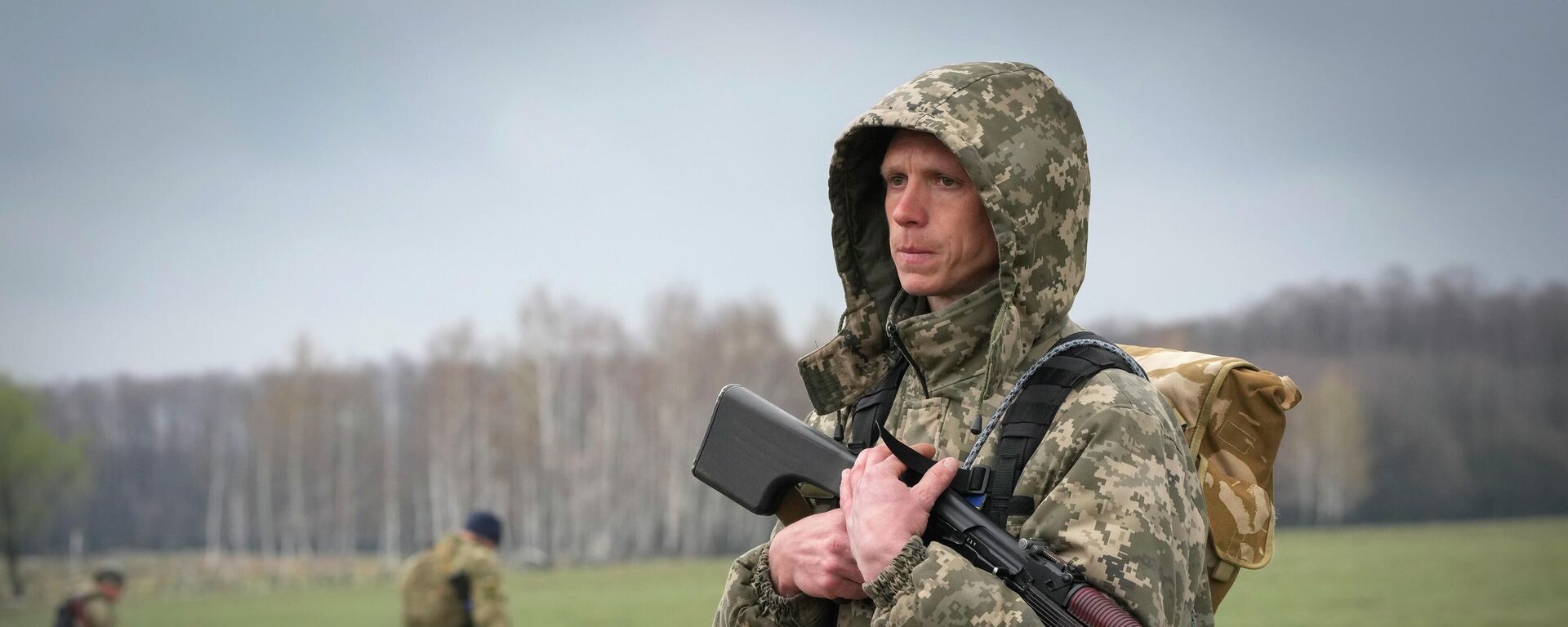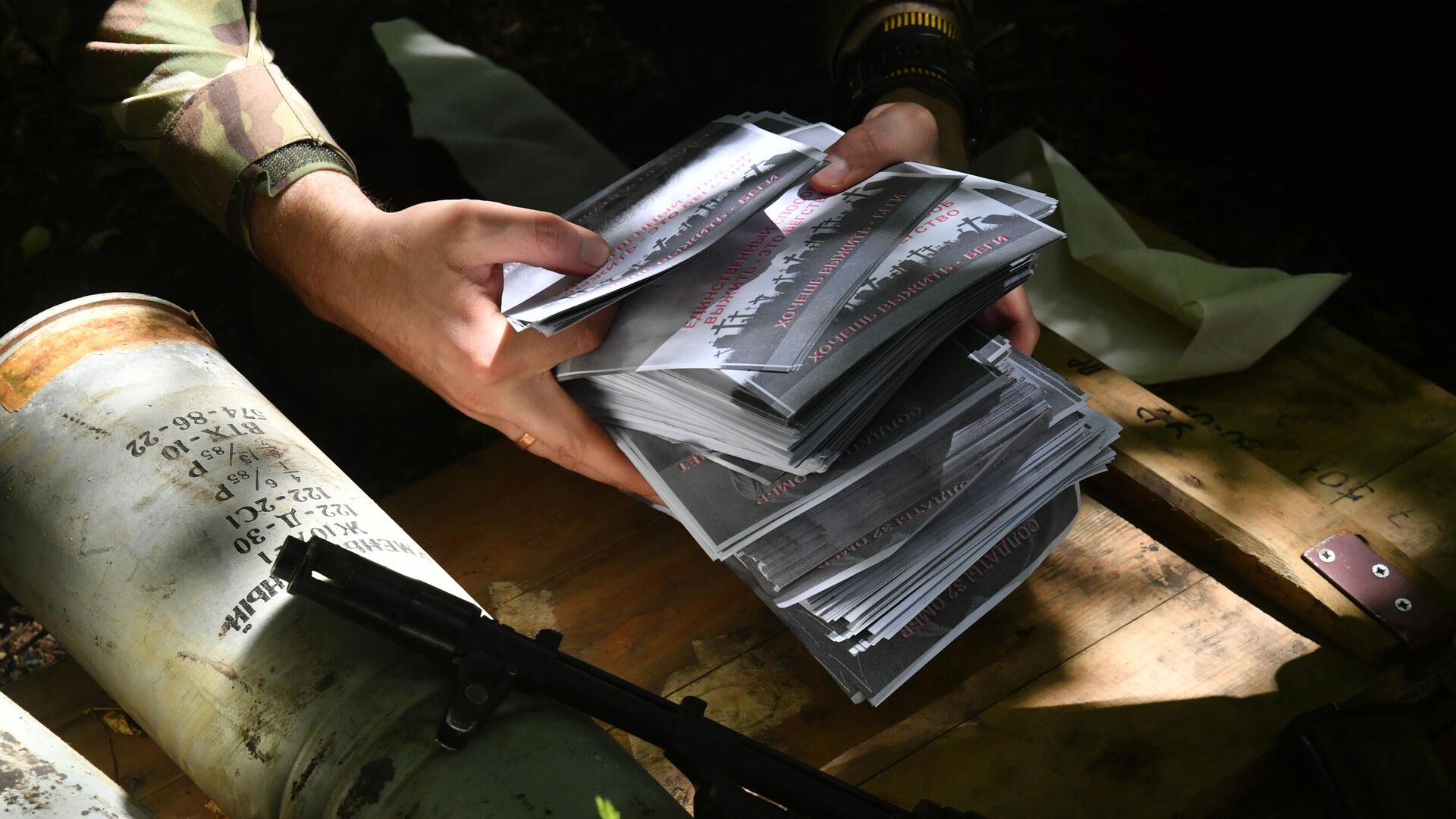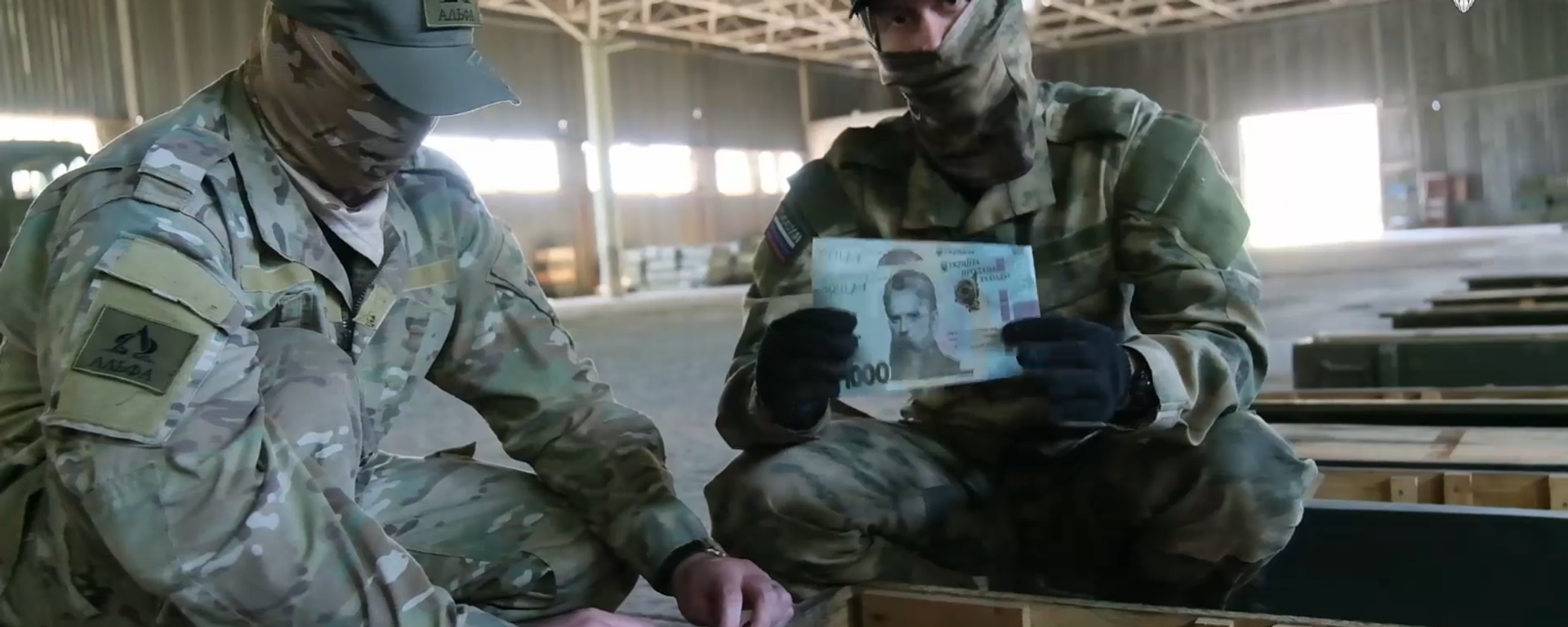https://sputnikglobe.com/20231004/russian-leaflets-offer-ukrainians-escape-from-meat-grinder-1113924286.html
Russian Leaflets Offer Ukrainians Escape From 'Meat Grinder'
Russian Leaflets Offer Ukrainians Escape From 'Meat Grinder'
Sputnik International
As Ukraine’s manpower losses on the battlefield increase amid the failed counteroffensive, the Russian military is firing leaflets, offering an alternative to pointless death.
2023-10-04T15:19+0000
2023-10-04T15:19+0000
2023-10-05T04:41+0000
russia's special operation in ukraine
russia
ukraine
leaflets
ben wallace
european union (eu)
ukrainian armed forces
ukrainian counteroffensive attempt
https://cdn1.img.sputnikglobe.com/img/07e7/0a/04/1113926880_0:160:3072:1888_1920x0_80_0_0_aa22a6d2d8a2fb11e0bf1c4698f6999b.jpg
The Kiev regime's counteroffensive has become nothing short of a meat-grinder, claiming the lives of at least 81,000 Ukrainian troops. Given that the Ukrainian Armed Forces have sustained huge losses in terms of military equipment and personnel, the Zelensky government has stepped up mobilization efforts, seeking to bring back draft-age adults from abroad.Kiev's Western backers are also urging Ukrainians to take up arms, with former UK Defense Secretary Ben Wallace insisting that the desire to preserve the Ukrainian youth for the future pales in comparison with the necessity to intensify fighting.Literally being turned into "cannon fodder," Ukrainian troops have increasingly started to surrender, with Russian military leaflets serving as a guide for them.What are Russian Military Leaflets?A typical leaflet could be styled as a Ukrainian, EU, or US banknote or a A5 flyer. It contains a text offering a combatant to lay down their arms and a detailed description of how to surrender safely. The leaflet also serves as a "pass" for a serviceman who has decided to give up.In addition, a radio frequency number (149.200 "Volga") and a Telegram account of Russia's Armed Forces are inscribed so that a Ukrainian soldier can seek help and get instructions. Sometimes Russian leaflets inform Ukrainian soldiers about a reward for military equipment.Small leaflets that look like banknotes have proven especially effective: on the one hand, money always attracts attention; on the other hand, it is small, allowing a Ukrainian soldier to secretly pick it up and hide it in his pocket or wallet.When Did the Russian Military Start Disseminating Leaflets?In fact, the Russian military started to disseminate leaflets well before Ukraine's botched counteroffensive.In March 2023, a Russian intelligence source told Sputnik that leaflets in the form of Ukrainian hryvnia had been dropped on the positions of Ukrainian militants in the Zaporozhye direction. These leaflets called on Ukrainians to surrender and contained a radio frequency and a messenger bot address by which they could contact Russian representatives.How are Leaflets Delivered to Ukrainian Positions?Russian leaflets can either be rolled and placed in artillery shells instead of explosives or dropped from unmanned aerial vehicles (UAVs) on Ukrainian positions. While drones deliver leaflets to the line of combat, rocket artillery shells send them straight into enemy rear areas.Thus, prior to shelling the enemy, Russian military personnel fire leaflets from Grad multiple launch rocket systems (MRLS). Per a representative of the Russian Ministry of Defense (MoD), they use BM-21 rockets, into which rolls with more than a thousand leaflets are loaded instead of explosives. These shells are distinguishable from conventional projectiles by their red color and the inscription "Agit."Per the Russian MoD, the ammunition fuses have a firing timer which is set depending on the distance to the target. The range of fire can be over 10 kilometers. After a shell explodes, leaflets are scattered over an area of more than a square kilometer so that every Ukrainian soldier can get one.In August, Russia's MoD released a video clip showing soldiers preparing special shells with leaflets and distributing them to Ukrainian troops in the Krasny Liman direction. The A5 leaflets called on Ukrainian soldiers to surrender and save their own lives.The other way of delivery is by drone. On October 4, the Russian military released footage showing UAVs scattering leaflets in the Dnepropetrovsk region, over the city of Nikopol. The leaflets called on Ukrainian soldiers to lay down their arms and advised Ukrainian civilians to avoid mobilization. A single UAV's basket can hold 500 leaflets styled as foreign currency – 100 dollars or 200 euros.Do Russian Leaflets Work?Given that the flow of the Ukrainian POWs who are giving up voluntarily has been steadily increasing over the past several months, one might conclude that leaflets work. The Russian MoD and leaders of Russia's new regions say that Ukrainian servicemen are surrendering in groups rather than individually.Russian psychological warfare specialists have told the Russian press that after the first drops of "propaganda shells," the audience of the MoD's Telegram channel grew tens of thousands of subscribers, most of whom were newly mobilized Ukrainians.In addition, the Russian military addresses their Ukrainian peers through radio- and television broadcasting, and contacts them on social media platforms. According to knowledgeable sources, thousands of Ukrainian servicemen have used the 149.200 "Volga" frequency – which was set up by Russian forces in mid-summer – to lay down their arms and defect to the Russian side.Per Russian specialists, this sort of psychological warfare is used to minimize losses on both sides. Back in March 2022, Russian and Ukrainian representatives negotiated an end to hostilities in Istanbul, Turkiye. It was the Kiev government, encouraged by its Western backers, who made a U-turn, legally prohibited peace negotiations with Moscow, and declared that it would fight to the bitter end, or, in other words, to the last Ukrainian.
https://sputnikglobe.com/20230519/price-of-life-hryvnia-styled-leaflets-rain-on-kiev-militants-1110462699.html
https://sputnikglobe.com/20230912/they-dont-want-to-die-pointless-death-why-ukrainian-troops-increasingly-surrender-1113318870.html
russia
ukraine
Sputnik International
feedback@sputniknews.com
+74956456601
MIA „Rosiya Segodnya“
2023
News
en_EN
Sputnik International
feedback@sputniknews.com
+74956456601
MIA „Rosiya Segodnya“
Watch Russian drone sneak behind Ukrainian lines to drop leaflets
Sputnik International
Watch Russian drone sneak behind Ukrainian lines to drop leaflets
2023-10-04T15:19+0000
true
PT0M59S
Sputnik International
feedback@sputniknews.com
+74956456601
MIA „Rosiya Segodnya“
ukrainian crisis, ukrainian conflict, ukrainian servicemen, russian leaflets, war in ukraine, russian special military operation, psychologila warfare, psy-op
ukrainian crisis, ukrainian conflict, ukrainian servicemen, russian leaflets, war in ukraine, russian special military operation, psychologila warfare, psy-op
Russian Leaflets Offer Ukrainians Escape From 'Meat Grinder'
15:19 GMT 04.10.2023 (Updated: 04:41 GMT 05.10.2023) As Ukraine’s manpower losses on the battlefield increase amid the failed counteroffensive, the Russian military is firing leaflets, offering an alternative to pointless death.
The Kiev regime's counteroffensive has become nothing short of a meat-grinder, claiming the lives of at least 81,000 Ukrainian troops. Given that the Ukrainian Armed Forces have sustained huge losses in terms of military equipment and personnel, the Zelensky government has
stepped up mobilization efforts, seeking to bring back draft-age adults from abroad.
Kiev's Western backers are also urging Ukrainians to take up arms, with former UK Defense Secretary Ben Wallace insisting that the desire to
preserve the Ukrainian youth for the future pales in comparison with the necessity to intensify fighting.
Literally being turned into "cannon fodder," Ukrainian troops have increasingly started to surrender, with Russian military leaflets serving as a guide for them.
What are Russian Military Leaflets?
A typical leaflet could be styled as a Ukrainian, EU, or US banknote or a A5 flyer. It contains a text offering a combatant to lay down their arms and a detailed description of
how to surrender safely. The leaflet also serves as a "pass" for a serviceman who has decided to give up.
In addition, a radio frequency number (149.200 "Volga") and a Telegram account of Russia's Armed Forces are inscribed so that a Ukrainian soldier can seek help and get instructions. Sometimes Russian leaflets inform Ukrainian soldiers about a reward for military equipment.
Small leaflets that look like
banknotes have proven especially effective: on the one hand, money always attracts attention; on the other hand, it is small, allowing a Ukrainian soldier to secretly pick it up and hide it in his pocket or wallet.
When Did the Russian Military Start Disseminating Leaflets?
In fact, the Russian military started to disseminate leaflets well before Ukraine's botched counteroffensive.
In March 2023, a Russian intelligence source told Sputnik that leaflets in the form of Ukrainian hryvnia had been dropped on the positions of Ukrainian militants in the Zaporozhye direction. These leaflets
called on Ukrainians to surrender and contained a radio frequency and a messenger bot address by which they could contact Russian representatives.
"We are working to prevent senseless bloodshed by Ukrainian soldiers. We are scattering leaflets calling for surrender," the source said. "This way they will be able to get in touch and discuss the exit point and the conditions for returning them home."
How are Leaflets Delivered to Ukrainian Positions?
Russian leaflets can either be rolled and placed in artillery shells instead of explosives or dropped from unmanned aerial vehicles (UAVs) on Ukrainian positions. While drones deliver leaflets to the line of combat, rocket artillery shells send them straight into enemy rear areas.
Thus, prior to shelling the enemy, Russian military personnel fire leaflets from Grad multiple launch rocket systems (MRLS). Per a representative of the Russian Ministry of Defense (MoD), they use BM-21 rockets, into which rolls with more than a thousand leaflets are loaded instead of explosives. These shells are distinguishable from conventional projectiles by their red color and the inscription "Agit."
Per the Russian MoD, the ammunition fuses have a firing timer which is set depending on the distance to the target. The range of fire can be over 10 kilometers. After a shell explodes, leaflets are scattered over an area of more than a square kilometer so that every Ukrainian soldier can get one.
In August, Russia's MoD released a video clip showing soldiers
preparing special shells with leaflets and distributing them to Ukrainian troops in the Krasny Liman direction. The A5 leaflets called on Ukrainian soldiers to surrender and save their own lives.
The other way of delivery is by drone. On October 4, the Russian military released footage showing
UAVs scattering leaflets in the Dnepropetrovsk region, over the city of Nikopol. The leaflets called on Ukrainian soldiers to lay down their arms and advised Ukrainian civilians to avoid mobilization. A single UAV's basket can hold 500 leaflets styled as foreign currency – 100 dollars or 200 euros.

12 September 2023, 19:15 GMT
Do Russian Leaflets Work?
Given that the flow of the Ukrainian POWs who are giving up voluntarily has been steadily increasing over the past several months, one might conclude that leaflets work. The Russian MoD and leaders of Russia's new regions say that
Ukrainian servicemen are surrendering in groups rather than individually.
Russian psychological warfare specialists have told the Russian press that after the first drops of "propaganda shells," the audience of the MoD's Telegram channel grew tens of thousands of subscribers, most of whom were newly mobilized Ukrainians.
In addition, the Russian military addresses their Ukrainian peers through radio- and television broadcasting, and contacts them on social media platforms. According to knowledgeable sources, thousands of Ukrainian servicemen have used the 149.200 "Volga" frequency – which was set up by Russian forces in mid-summer –
to lay down their arms and defect to the Russian side.Per Russian specialists, this sort of psychological warfare is used to minimize losses on both sides. Back in March 2022, Russian and Ukrainian representatives negotiated an end to hostilities in Istanbul, Turkiye. It was the Kiev government, encouraged by its Western backers, who
made a U-turn, legally prohibited peace negotiations with Moscow, and declared that it would fight to the bitter end, or, in other words, to the last Ukrainian.







